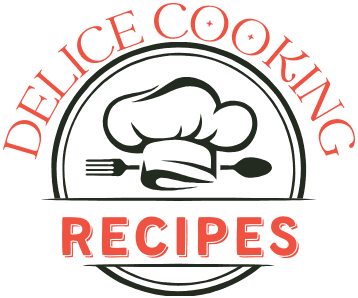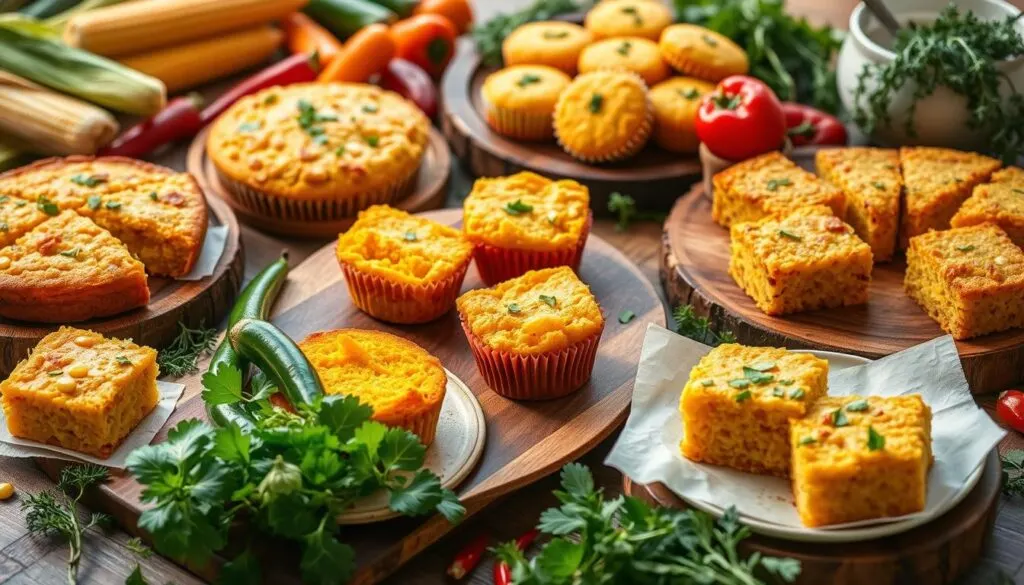Cornbread is more than a Southern staple; it connects us to Indigenous cultures and early settlers. The reason sugar doesn’t belong in cornbread shows the heart of Southern cooking. It’s about the economic and agricultural history of the area.
Historically, cornbread was made with what was available, not sugar. This made it a savory dish, not sweet. Traditional recipes use cornmeal, water, and salt. This lets corn’s natural flavors stand out, making the dish a perfect match for Southern flavors.
When thinking about adding sugar to cornbread, remember its rich history and cultural value. This dish is a true reflection of Southern traditions.
Table of contents
- The Historical Roots of Cornbread: Why Sugar Doesn’t Belong
- The Evolution of Cornbread Recipes
- The Real Reason Sugar Doesn’t Belong in Southern Cornbread
- Southern Cornbread vs. Northern Variations
- Why Southern Cooks Avoid Sugar
- Savory Southern Cornbread: A Perfect Pairing
- Cornbread as Comfort Food: A Sugar-Free Tradition
- Modern Adaptations and Deviations
- How to Make Authentic Southern Cornbread
- Exploring Substitutes for Sugar in Cornbread
- FAQ
- Conclusion
The Historical Roots of Cornbread: Why Sugar Doesn’t Belong
Exploring the history of cornbread reveals its deep roots in Southern cooking. It started with Indigenous cooking, where corn was a key ingredient. Native Americans made flatbreads from ground corn, a step towards cornbread.
When Europeans came, they took these recipes and added their own touches. They used dent corn grown locally. This mix of traditions shaped cornbread into what we know today.
Indigenous Influences on Cornbread Without Sugar
The story of cornbread begins with Native Americans. They turned corn into essential foods through their cooking. Early settlers saw corn’s value and added it to their meals.
This blending of traditions led to the cornbread we love today. It shows the area’s farming ways.
Cornmeal’s Role in Authentic Southern Cornbread
Cornmeal is vital in Southern cooking, used in cornbread and more. Stone-ground cornmeal makes Southern cornbread special. It gives the bread a denser, crumblier texture.
This sets Southern cornbread apart from its sweeter, fluffier Northern version. Cornbread in the South is more than food; it’s a symbol of hospitality and heritage.
The Evolution of Cornbread Recipes
The way cornbread recipes have changed shows how technology and taste have evolved. At first, cornbread was made with stone-ground cornmeal. This gave it a rich, earthy taste. Later, with the invention of roller milling, cornbread’s texture and flavor began to shift.
Transition from Stone Grinding to Roller Milling
Stone grinding vs. roller milling changed how cornmeal was made. Stone grinding made cornmeal coarser and kept more of the corn’s natural goodness. This gave cornbread a bold flavor that many love.
On the other hand, roller milling made cornmeal finer and lighter. This is often used in today’s cornbread. This change has sparked debates about what makes cornbread authentic versus what’s convenient.
Impact of Modern Cornmeal on Traditional Recipes
Today, many cornbread recipes use the finer cornmeal from roller milling. This makes cooking easier but can lose the traditional taste. Southern cooks often say that using stone-ground cornmeal is key to keeping the recipe true to its roots.
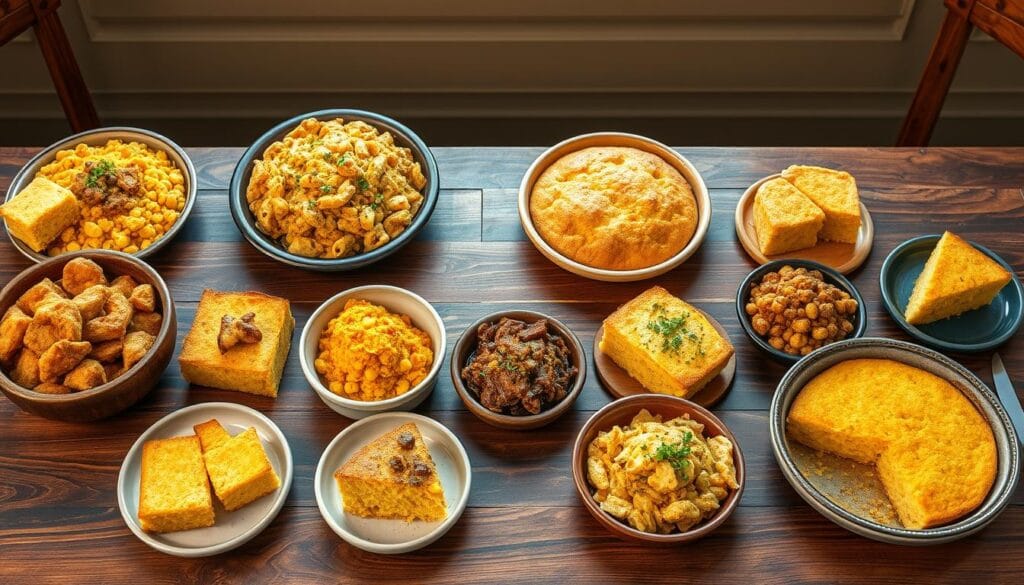
| Milling Method | Texture | Nutritional Retention | Usage in Cornbread |
|---|---|---|---|
| Stone Grinding | Coarse | High | Traditional recipes |
| Roller Milling | Fine | Lower | Modern recipes |
The Real Reason Sugar Doesn’t Belong in Southern Cornbread
The debate about sugar in cornbread reveals a deeper *cultural significance* in Southern cooking. Cornbread is a beloved dish in Southern homes, often served with pinto beans and black-eyed peas. These pairings highlight the bold flavors of the South, where the *natural sweetness of cornmeal* adds a perfect balance.
Cultural Significance of Savory Over Sweet
In Southern cooking, cornbread without sugar shows a preference for savory tastes. Recipes passed down through generations reflect a dedication to authenticity. Cornmeal, made from dent corn, has its own distinct taste, making sugar unnecessary. This *cultural significance* is why many Southern families stick to traditional cornbread.
Natural Sweetness of Cornmeal
The *natural sweetness of cornmeal* makes cornbread satisfying. Using high-quality cornmeal, this dish has a rustic charm that adds depth without being too sweet. Traditional recipes often include buttermilk or cheese to boost flavor, showing the beauty of simplicity in Southern cuisine. Many believe the true beauty of cornbread lies in its natural ingredients, creating a wholesome dish.
Southern Cornbread vs. Northern Variations
The debate between Southern and Northern cornbread has lasted for centuries. It often centers on whether to include sugar. This shows how different regions have their own cornbread recipes, each with its own story.
Key Differences in Ingredients and Preparation
In the South, cornbread is made with stone-ground cornmeal, buttermilk, and salt. It’s dense and savory. The South doesn’t use sugar, which makes the cornbread rich and perfect for pairing with other dishes.
Northern cornbread, on the other hand, is sweeter and lighter. It includes sugar, fine cornmeal, and more flour. This difference shows how Northern states grow sweeter corn, making their cornbread softer.
Understanding the Preference for Savory Cornbread
The South loves savory cornbread because sugar was rare in the past. Southern families made simple, hearty dishes. They believed cornbread should be a side, not a sweet treat.
This tradition shows the heart of Southern cooking. It’s about blending flavors and textures to make a meal special.
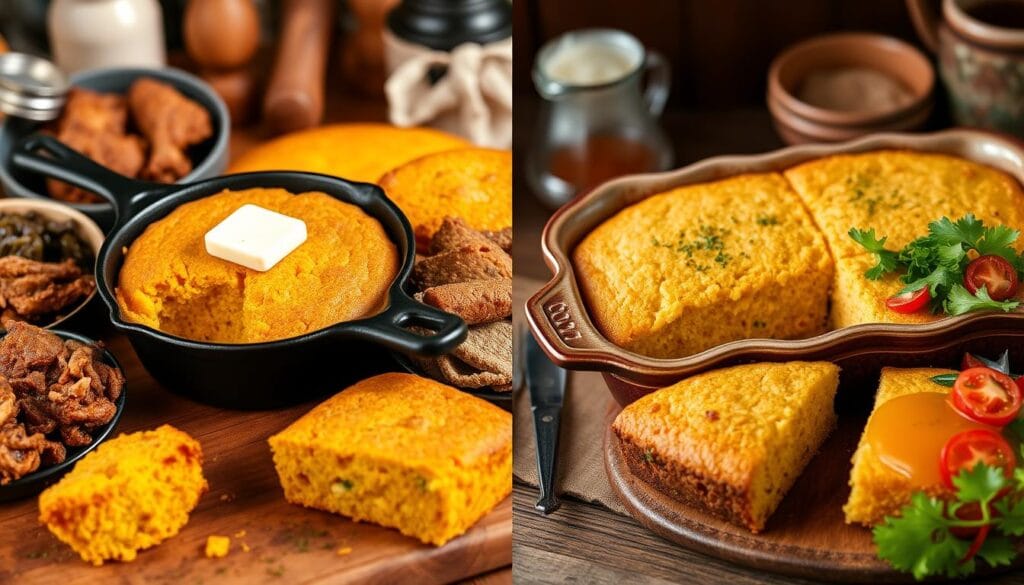
Why Southern Cooks Avoid Sugar
Traditional Southern cornbread doesn’t have sugar for good reasons. It’s not just about taste. It’s about saving money in the kitchen. Sugar was a luxury for many, so cooks focused on using what they had.
This way, they made food that was both tasty and filling. It helped families stretch their limited resources.
Economic and Practical Considerations
The South’s economic struggles shaped its cooking. Cooks skipped sugar to use cheaper, more common ingredients. This made meals more filling and affordable.
This approach also encouraged creativity. It brought out the natural sweetness in cornmeal, making cornbread even better.
Generational Influence on Recipe Traditions
Recipes passed down through generations tell stories of thriftiness. Grandmothers and mothers taught the value of simple ingredients. Using stone-ground yellow cornmeal adds depth to dishes.
By avoiding sugar, Southern cooks honor their culinary heritage. They keep the tradition of cornbread alive, connecting each generation to their roots.
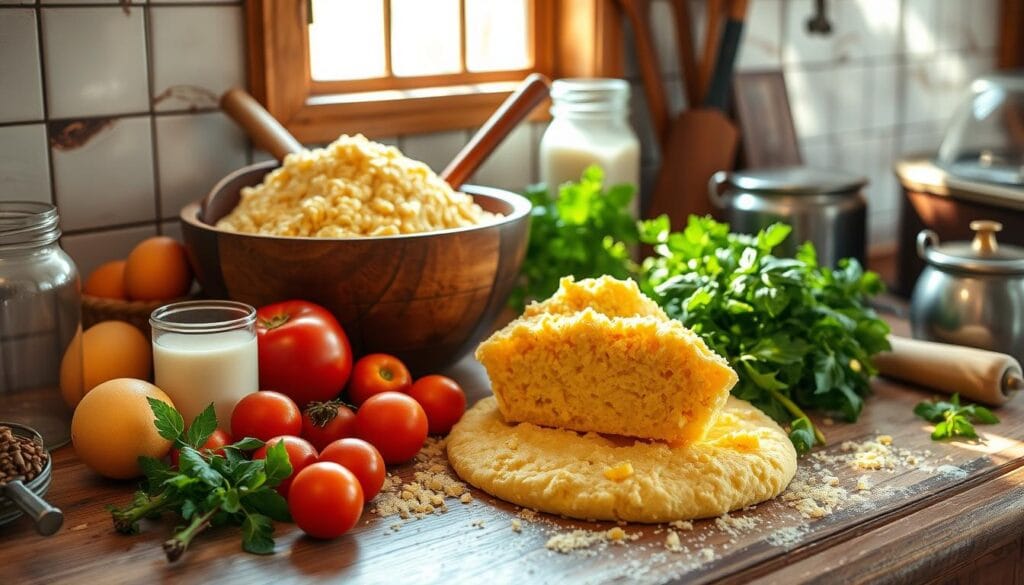
Savory Southern Cornbread: A Perfect Pairing
Southern cooking is all about bold, rich flavors. It’s about making dishes that show off cultural heritage and creativity. At the heart of this is Southern cornbread, which makes any meal better with its unique taste.
Balancing Flavors in Traditional Dishes
In Southern cooking, getting flavors right is key. Dishes often have strong, savory tastes that pair well with cornbread’s subtle sweetness. Knowing what to eat with cornbread opens up a world of flavors. Think of gumbos and rich chili, where cornbread enhances the main dish’s taste.
Pairings That Complement Savory Cornbread
When thinking about what to eat with cornbread, turn to Southern classics. Some top choices include:
- Gumbo
- Chili
- Collard Greens
- Frogmore Stew
- Oyster Dressing
These dishes match the savory spirit of Southern cooking, making meals warm and nostalgic. The deep umami from ingredients like beef tallow in cornbread shows its importance in a great meal.
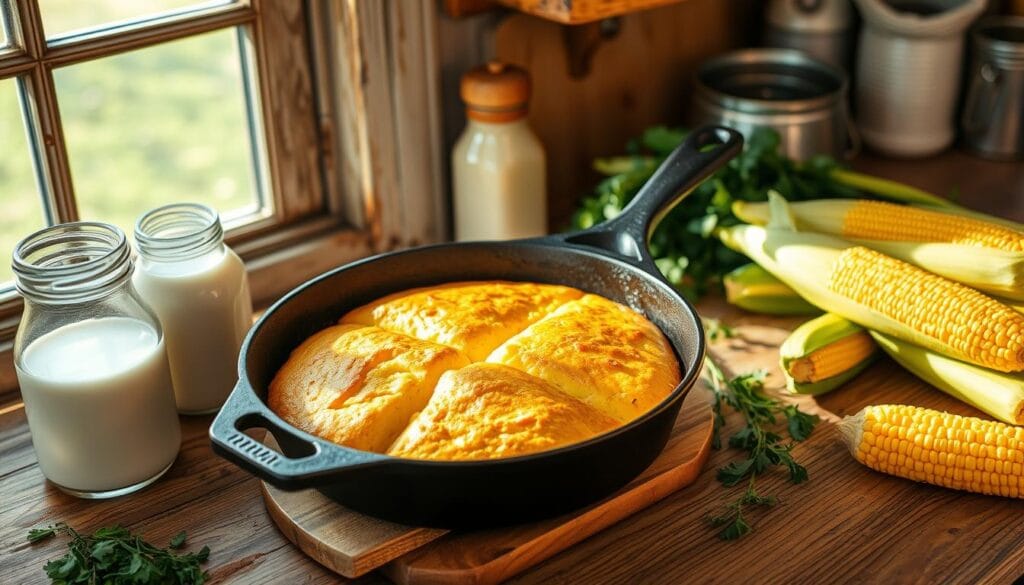
| Dish | Flavor Profile | Why It Pairs Well |
|---|---|---|
| Gumbo | Spicy, Rich | Balances the spice with a buttery cornbread |
| Chili | Hearty, Comforting | Provides a complementary texture and flavor |
| Collard Greens | Earthy, Savory | Enhances the richness of greens with texture |
| Frogmore Stew | Seafood-rich, Spicy | Balances seafood spice and adds texture |
| Oyster Dressing | Salty, Savory | Brings a unique flavor depth alongside cornbread |
Exploring these pairings will lead to satisfying meals and a deeper appreciation for Southern cooking. Each bite is a sensory delight, showing why this tradition is so cherished in the South.
Cornbread as Comfort Food: A Sugar-Free Tradition
Cornbread is a key part of Southern kitchens, filled with deep meaning as comfort food. Every bite brings back memories of family times and meals shared. It creates a strong bond with food that lasts through generations. The true value of cornbread is in the stories it tells and the traditions it brings together.
The Emotional Resonance of Traditional Recipes
Traditional cornbread recipes bring a sense of home and nostalgia. Each family adds their own twist, making it a treasured part of their cooking history. Enjoying cornbread can remind us of special moments at family gatherings or Sunday dinners. It strengthens family bonds through shared meals.
Generational Ties and Family Traditions
Family traditions with cornbread connect past and present. Recipes passed down come with stories that make cooking more meaningful. Whether it’s Grandma’s cornbread muffins or savory cornbread at holidays, these dishes tell a family’s story. Making cornbread together can also bring families closer, making it a key part of family life.
Modern Adaptations and Deviations
In today’s world, you might see more modern cornbread recipes. Sweetened cornbread recipes are becoming popular, sparking debates about taste and culture. Traditionalists love the real taste of cornbread, making this topic interesting for cooks and food lovers.
The Rise of Sweetened Cornbread Recipes
Contemporary cooks are making sweetened cornbread to attract more people. They add honey, maple syrup, and other sweeteners. This change brings a new flavor that excites many.
Many want to mix old traditions with new ideas. This mix encourages creativity in the kitchen.
Maintaining Tradition Amid Changing Tastes
Despite changing tastes, keeping traditions alive is key in Southern cooking. Cooks share old recipes that show the true essence of cooking. This effort keeps the real taste of cornbread alive, even with new sweetened recipes.
| Aspect | Traditional Cornbread | Sweetened Cornbread |
|---|---|---|
| Flavor Profile | Savory and rich | Sweet with hints of flavor |
| Main Ingredients | Cornmeal, buttermilk, eggs | Cornmeal, buttermilk, sugar or honey |
| Cultural Significance | Preservation of Southern heritage | Modern twist on a classic |
| Preparation Methods | Often baked in cast iron skilllets | May use pans or muffin tins |
How to Make Authentic Southern Cornbread
Making authentic Southern cornbread is a fun journey. It uses key ingredients to bring out the Southeast’s flavors. Knowing what to use and how to prepare it will make your dish a true Southern delight.
Essential Ingredients for Flavorful Cornbread
To make a tasty Southern cornbread, you’ll need a few important ingredients:
- Stone-ground cornmeal
- Buttermilk
- Baking soda
- Pork cracklings (for added texture and flavor)
- Salt
- Eggs
- Vegetable oil or melted butter
Pork cracklings make your cornbread special. They mix meat and fat for a richer taste. Blend half of them into the batter and sprinkle the rest on top before baking.
Step-by-Step Guide to Preparation
Here’s how to make cornbread that will wow everyone:
- Preheat your oven to 425°F (220°C) and place a cast-iron skillet in to heat.
- In a mixing bowl, combine the dry ingredients: stone-ground cornmeal, baking soda, and salt.
- In a separate bowl, whisk together the wet ingredients: buttermilk, eggs, and vegetable oil or melted butter.
- Slowly mix the wet and dry ingredients until just combined. Don’t overmix for a light texture.
- When the skillet is hot, pour the batter in. The sizzling sound means it’s cooking evenly.
- Top the batter with the remaining pork cracklings for a crunchy topping.
- Bake for about 20-25 minutes, or until it’s golden brown and a toothpick comes out clean.
This method not only makes your cornbread delicious but also honors Southern cooking traditions. Once it cools, your authentic Southern cornbread is ready to enjoy.
| Ingredient | Amount | Purpose |
|---|---|---|
| Stone-ground cornmeal | 2 cups | Base flavor and texture |
| Buttermilk | 1 cup | Adds moisture and tanginess |
| Baking soda | 1 tablespoon | Leavening agent for rise |
| Pork cracklings | 1 cup | Enhances flavor and adds crunch |
| Salt | 1 teaspoon | Balances flavors |
| Eggs | 2 | Binding agent |
| Vegetable oil or melted butter | 1/4 cup | For richness and moisture |
Exploring Substitutes for Sugar in Cornbread
Finding sugar substitutes in cornbread can change classic recipes. It keeps the traditional flavors alive. By using natural sweeteners and other ingredients, your cornbread stays true to its roots but also appeals to today’s tastes.
Natural Sweeteners that Align with Tradition
Using honey or molasses instead of sugar is a great choice. These natural sweeteners add a gentle sweetness. A little goes a long way, making sure the flavors balance out.
Non-Sugar Ingredients to Enhance Flavor
Ingredients like buttermilk and bacon grease can also boost flavor. Buttermilk adds a tangy taste and helps the cornbread stay moist. Bacon grease brings a smoky flavor that complements the cornmeal.
Adding herbs or spices can also make the cornbread even more delicious. These ingredients add depth and complexity to the dish.
FAQ
Southerners often skip sugar in cornbread. They stick to traditional, savory dishes. This lets the natural sweetness of dent cornmeal shine through.
Adding sugar is up to you. But, many Southern recipes suggest avoiding it. They aim for a savory taste that pairs well with other dishes.
No, cornbread was never meant to be sweet. It started as a savory dish. Early settlers and Indigenous people focused on flavor, not sweetness.
Try using honey or molasses instead of sugar. You can also add cheeses, herbs, or spices. This keeps the cornbread’s true taste.
Traditional Southern cornbread doesn’t use sugar. It relies on the cornmeal’s natural flavor.
A classic recipe includes stone-ground cornmeal, buttermilk, baking soda, and salt. Baked in a hot skillet, it’s savory and delicious.
Southern cornbread is denser and less sweet. It focuses on savory tastes. Northern cornbread is lighter and sweeter, often with added sugar.
Sugar was once a luxury in the South. Cooks focused on simple, flavorful dishes. This kept recipes true to their roots.
Cornbread is more than food in the South. It’s tied to family and tradition. It brings warmth and comfort to gatherings.
Conclusion
The journey through Southern cornbread’s culture and history shows its deep importance. It’s more than a side dish; it’s a symbol of heritage. Choosing to leave out sugar is a nod to tradition and practicality.
By using cornmeal’s natural flavors, you enjoy its rich taste. This honors the cooking ways of our ancestors.
Thinking about cornbread, we see it as a comfort food for all occasions. Its sugar-free recipe connects us to our past. It shows the simplicity and authenticity of early settlers and Native Americans.
By making cornbread the traditional way, you taste the South’s essence. It’s a way to connect with your culinary roots.
Enjoying authentic Southern cornbread is more than eating. It’s about the comfort and connection to our cooking heritage. Each bite shares a story worth telling.
